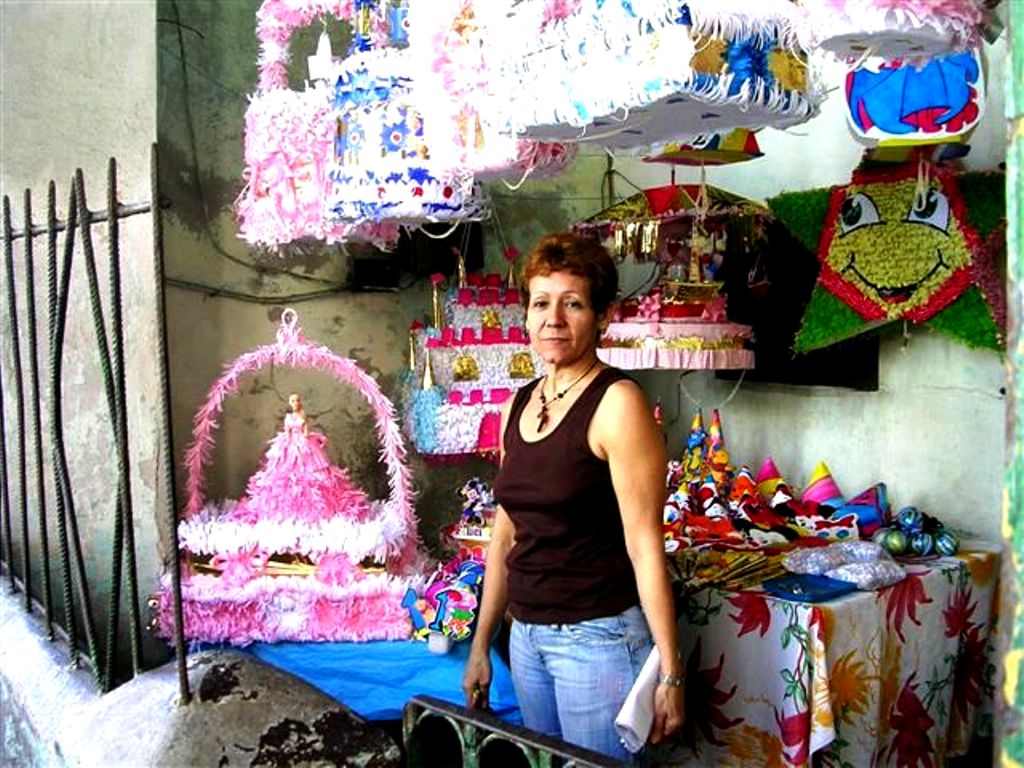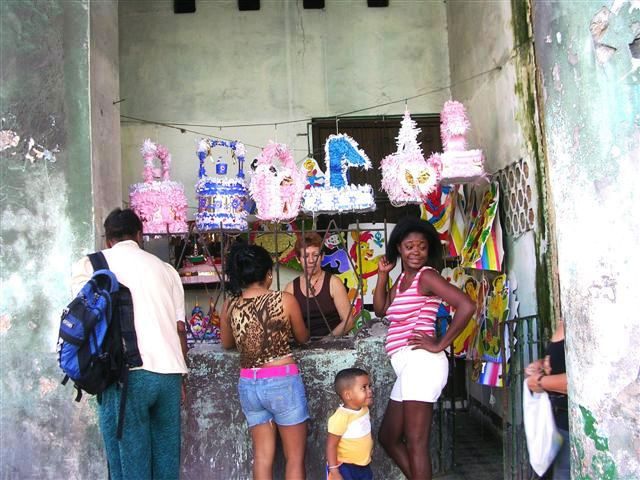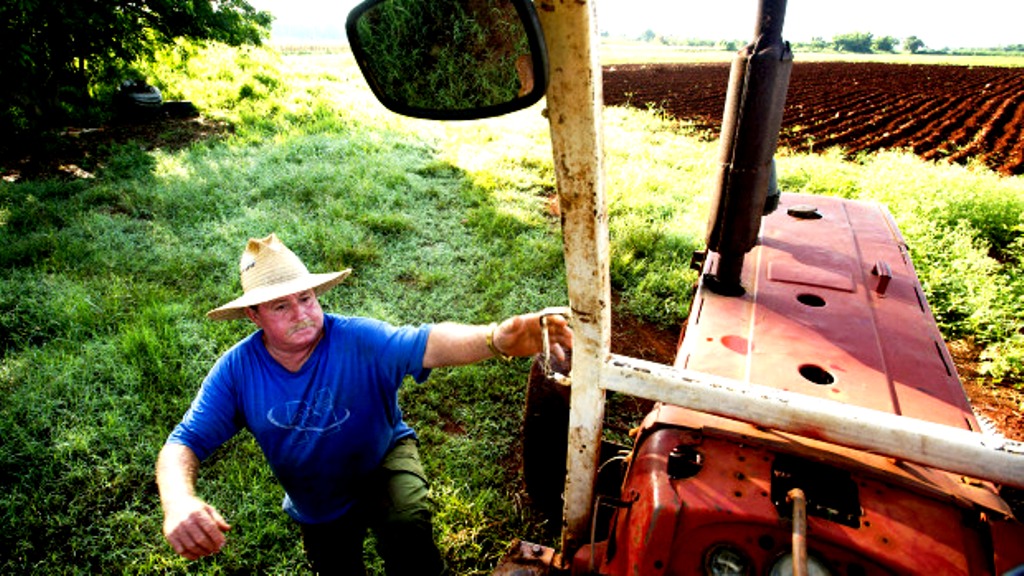Small acts of free enterprise attest to reform looming large in Cuba
By SONIA VERMA
Globe and Mail, Toronto, October 18, 2011
Regime can no longer afford to finance socialist ideals upon which it was founded
Original Article Here: Small acts of free enterprise….
Just off the Malecon, Havana’s famous seaside corniche, Omar Gatierrez strikes a deal to sell his ’56 Oldsmobile for the rough equivalent of $14,500. It’s the most money he’s ever made.
At a burger joint not far from there, Alfredo Garcia, an economist, shells out twice as much as he normally would for a strawberry milkshake just because it tastes good. Around the corner, Lazaro Rafael, a mechanic, haggles over the price of repairing an infirm Peugeot on the street near the sea where he lives.
 Nerci, Cuenta Propista and Artisan, Habana Vieja, Photo by Arch Ritter, November 2008
Nerci, Cuenta Propista and Artisan, Habana Vieja, Photo by Arch Ritter, November 2008
 These small acts of free enterprise would have been inconceivable in Fidel Castro’s Cuba. Under his younger brother, Raul, however, they add up to dramatic economic reform that is quietly reconfiguring the country into something altogether different. Cuban authorities are careful to depict this restructuring as upgrading the revolution rather than forsaking it, yet underpinning it all is an overriding sense of urgency to change.
These small acts of free enterprise would have been inconceivable in Fidel Castro’s Cuba. Under his younger brother, Raul, however, they add up to dramatic economic reform that is quietly reconfiguring the country into something altogether different. Cuban authorities are careful to depict this restructuring as upgrading the revolution rather than forsaking it, yet underpinning it all is an overriding sense of urgency to change.
Floated by fickle Chinese credit and Venezuelan oil, the regime can no longer afford to finance the socialist ideals upon which it was founded. With Cuba at a crossroads, the future remains unclear. One path appears to lead to nowhere, should the regime prove too brittle to allow private enterprise to truly flourish. The alternative route, others worry, would morph the island into something resembling a Floridian mega-mall.
Both outcomes would be disastrous. Most analysts believe the country’s true destiny lies in becoming a mixed economy where the state loosens its grip over some sectors but maintains leverage over others. The aim, Cuban sources said, is to have 35 per cent of the economy privatized by 2015. Achieving this elusive balance, however, will prove exceedingly difficult. The reforms that have been rolled out so far – such as allowing cars to be sold and licensing small businesses – have been relatively painless, eclipsing more agonizing ones that lie ahead.
For Cubans, many of whom have virtually no memory of life before the revolution, the reforms are confusing and their consequences unknown. The regime has vowed to implement a progressive tax structure to avoid a Russian-like result where vast amounts of wealth is concentrated in the hands of the few. But a schism of class – however minor – would symbolically violate Mr. Castro’s symbolic contract with his people.
Over the next five years, for instance, the regime intends to lay off up to a million public-sector workers, equalling 10 per cent of its work force. Food rations, for which many Cubans rely on for their daily sustenance, are also due to be phased out. Betting on an increase in productivity, the government has promised to boost wages, but economists doubt it will be enough to keep pace with a rising cost of living, as goods are removed from the ration card.
“These larger state-led reforms are going to be wrenching,” said Christopher Sabatini, editor-in-chief of Americas Quarterly. One of the biggest obstacles to real change in Cuba, he argues, is the awkward paradox the regime finds itself in: Downgrading its leverage in order to save itself from ruin.
“There’s an inherent tension in any economic reform that involves the Cuban state reducing its own authority over the economy, which is [Fidel] Castro’s real legacy,” Mr. Sabatini explained.
Another problem is that while Cuban authorities seem to have a clear idea of the main focus of the restructuring – reducing the state payroll, nourishing the private sector, boosting food production – the government is vague on its timeline for implementing the changes and even more so on how it plans to deal with any fallout. The haphazard transition means that whenever one of the 311 new decrees issued by the Communist Party at its April Congress becomes law, few people on the street in Havana seem to notice or understand why they should care.
Josefina Vidal, director of the North America Department for Cuba’s Ministry of Foreign Affairs, said the protracted rollout is deliberate: “It’s a slow process because we are very much interested in avoiding any kind of social impact. We don’t want anybody to be abandoned or left behind,” she said in a recent interview with The Globe And Mail. Some measures, she acknowledged, were easier to implement than others.
When it comes to defining Cuba’s end goal, officials are equally open-ended, maintaining the state is not trying to emulate other countries – such as China or Vietnam – but rather aiming to pursue an entirely unique set of reforms. Observers, however, disagree.
“They want this to be a made-in-Cuba type of economic system. But if it is made in Cuba it certainly resembles the Chinese approach, and it’s moving more and more in that direction,” said Arch Ritter, an economist at Carleton University who specializes in Cuba.
As he points out, Cuba’s economy is nowhere near China’s in terms of scale or scope. Also, China’s ruling Communist Party is less ossified than Cuba’s, which is still dominated by octogenarians. The recent death Cuba’s minister of defence, Julio Casas Regueiro, at the age of 75, highlighted the frailty of the state’s older generation of leaders who are still firmly in charge.
Without political renewal, analysts say Cuba’s economic reforms are doomed. “They are trying to let the economic genie out of the bottle while keeping the political genie in. That’s not going to work,” predicted Arturo Lopez-Levy, a former political analyst in the Cuban Interior Ministry and a lecturer at the University of Denver.
Meanwhile it remains unclear how Cuban society, much less the regime, will deal with social changes that will inevitably follow the economic ones. How will the state prevent Cuba’s new generation of entrepreneurs from accumulating the kind of wealth that could give rise to a new upper class? How will it ensure all Cubans have access to capital, not just the ones with relatives in Europe or Miami? How will it provide incentives for productivity and initiative if it plans to heavily tax the rewards of that?
“Don’t be fooled,” Mr. Sabatini says. “They want to preserve the system in many ways … at least the perks of the system.”
As sweeping as Cuba’s current economic reforms are, key enterprises such as mining, oil and sugar production will remain in the hands of the state. Cuba’s health system and its lucrative tourist industry will also remain unchanged, at least for now. The rebranding of the revolution, Mr. Sabatini argues, is still very much a work in progress.
“What was Castroism anyways? It was really about survival. Cuba’s future will boil down to whatever it needs for political and economic survival, rather than any principled commitment to the revolution,” he said.


